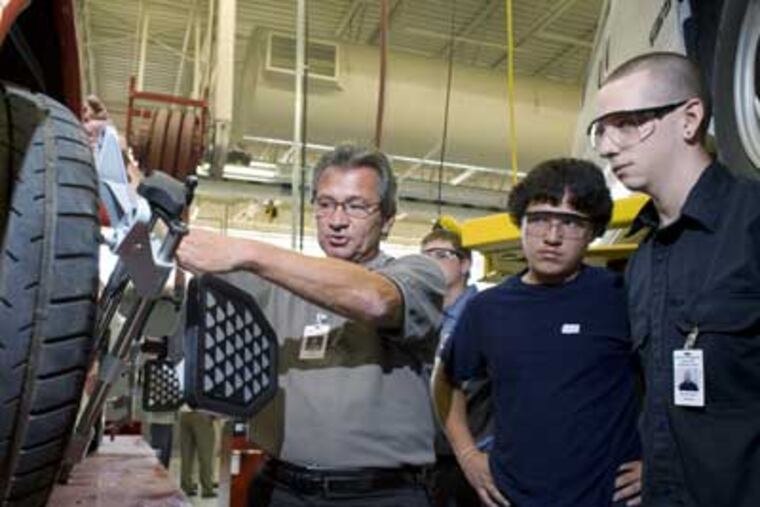Western Montgomery County career, tech center goes state of the art
A group of Western Montgomery Career and Technology Center students gathered excitedly last week around a new state-of-the art gadget, putting the $27,000 computerized automobile wheel-alignment system through its paces.

A group of Western Montgomery Career and Technology Center students gathered excitedly last week around a new state-of-the art gadget, putting the $27,000 computerized automobile wheel-alignment system through its paces.
The equipment, in the spacious new wing of the center, provides a welcome improvement from the cramped quarters, with outdated tools, of the past.
"You can't even begin to describe the difference," said Matthew Garcia, a senior who splits his time between the technical school and Upper Perkiomen High School. "Everything is brand new and high-tech - it's the best anybody could work on. It really doesn't get any better than this."
That sentiment can be heard from students and instructors in just about every one of the 16 half-day programs at the school, which serves three districts in the western end of Montgomery County: Pottsgrove, Spring-Ford Area, and Upper Perkiomen.
The center, in Limerick, is starting the school year after completing a $36.7 million renovation that included adding 50,000 square feet of space. The school, with an enrollment of 450 this year, opened in 1966, but it has been decades since there was such a large-scale upgrade.
Students coming back to other newly renovated high schools might typically rave about a new chemistry lab or a spacious gym. At Western Montgomery, they are excited about the new alignment system, the 10 shining hydraulic-auto lifts, the high-tech paint booth, the new 80-seat "restaurant" in which culinary students will be serving food to community residents, and the cosmetology wing, which looks like a beauty salon instead of a classroom.
After all, if the equipment they work with is similar to what they would use on the job, students might have an added advantage in landing work.
The administrators who run the schools are acutely aware of that. The new areas to train health-care workers, for example, are being set up with simulated medical records and a doctor's office, said Joseph Greb, the school's administrative director. "We try to mimic the workplace as much as possible."
High-achieving school districts such as Pottsgrove, Spring-Ford, and Upper Perkiomen are more likely to brag about the number of students attending Ivy League schools than the number who go on to work as auto mechanics, health technicians, police officers, or carpenters.
But career and technical schools like Western Montgomery play a key role in the state's education system.
There are 85 technical schools in Pennsylvania, providing an education to more than 53,000 students last school year, a figure that has declined somewhat over the last few years, but not by much.
That number makes up about 9 percent of all public high school students, and about 12.5 percent of those in grades 10 to 12, the grades taught in most career and technical schools. Thousands more students also take similar courses in their home school districts.
A student who earns a high school degree in career and technical education will have more earning power than someone with a general diploma, said Chester Wichowski, associate director of Temple University's career and technical education program and the president of the Pennsylvania Association for Career and Technical Education.
"We are running into shortages of trades people - a good mechanic, plumber, or electrician can do pretty well, and these are jobs that aren't exported offshore," he said.
Many students go on to take additional courses after high school, Wichowski said, adding that "while we don't need an unskilled workforce, we do need a semiskilled or professionally based workforce, and that's what we get from these schools."
At Western Montgomery, for example, 42 percent of the 2009 graduating class went on to community college or technical school or sought four-year degrees, a survey taken in October of that year showed. Of those going into the workforce, 27 percent were employed in a field related to their training; 34 percent were working part time.
Even in today's poor economy, with high unemployment, many students still find jobs after they graduate, said Bill Scott, an Upper Perkiomen school board member. "These are the kids are who are getting jobs right now, not the college graduates."
This is the second year that the school has offered two sets of half-day career and technology classes to its students, rather than having them stay at the center all day and take academic courses there as well. That change, the addition of classes for 10th graders, and the renovation pushed enrollment up from 270 a few years ago to its current level.
Students said they like attending their home high schools. "You get to see your friends and teachers [back in your home district], then you get to come here and work on autos the rest of the time - it's pretty cool," said Josh Warfel, a junior from the Spring-Ford district.
Greb said that students also get to choose from a much greater variety of academic courses at their home high schools than they could get at Western Montgomery. "We realized: Why don't we each do what we do best?" he added.
With the renovation and the planned addition of new courses in dental technology, graphic design, and the building trades, the school is hoping to expand its enrollment by a couple of hundred in the next few years, Greb said.
"We now have a state-of-the-art vocational institution that our three districts should be proud of," said Scott, the school board member. "We plan to grow."